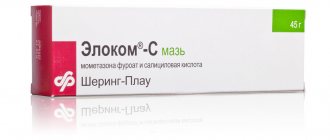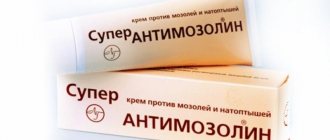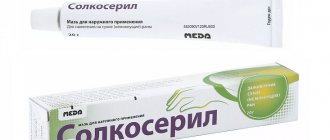More details
Turpentine ointment is a time-tested remedy used for pathologies of the musculoskeletal system and pain syndrome. Contains terpene compounds obtained from the resin of coniferous trees, which have medicinal properties.
- Indications for use
- About contraindications and adverse reactions
- Is it possible for pregnant women and children
- How to use, dosage
- How to store ointment
- Cost, where to buy
- Reviews
- Analogs
Pharmacodynamics and pharmacokinetics
The ointment has a disinfecting, irritating, warming and distracting effect. The active component of the product - purified turpentine - turpentine oil is produced from trees, mainly pine trees. The alpha-pinene terpene from this oil easily and quickly penetrates the upper layers of the epidermis , irritates nerve endings and provides blood to the tissues. At the same time, specific inflammatory synthesizers begin to be released, the vessels dilate, endorphins and enkephalins , which eliminate pain. The distracting effect of the ointment develops due to the receipt of an additional impulse along the nerve endings, signaling irritation and burning at the site of application of the product.
Due to the ability to enhance microcirculation of blood and lymph, the ability to irritate specific cough centers, the ointment has a mucolytic and expectorant effect.
Turpentine ointment for external use 20% 25 g tube 1 pc. in Moscow
Latin name
TEREBINTHIN OINTMENT
International nonproprietary name
Terebinthin ointment
Release form
Ointment
Package
25 g - aluminum tubes (1) - cardboard packs.
Description
white ointment with a yellowish tint, with the smell of turpentine.
pharmachologic effect
Herbal product. It has a local irritating, distracting and antiseptic effect. The main active ingredient of turpentine oil (purified turpentine), terpene alpha-pinene, is lipophilic, easily penetrates the epidermis and irritates the endings of sensory nerves. A certain contribution, apparently, is made by endogenous biologically active substances released under the influence of oil. Histamine and other inflammatory mediators cause vasodilation, slight tissue swelling, and hyperemia. Enkephalins and endorphins contribute to pain relief. The mechanism of the distracting effect is explained by the fact that two streams of excitation enter the central nervous system - from pathologically altered internal organs and from the surface of the skin, with the latter being dominant. The perception of afferent impulses is weakened. In addition, a trophic effect is carried out through the cutaneous-visceral reflex (with irritation of the sensitive zones of Zakharyin-Ged) and according to the type of axon reflex (antidromically along postganglionic sympathetic fibers). When administered via inhalation, alpha-pinene reflexively stimulates cough and has expectorant and mucolytic effects.
Indications
Used as a massage and warming agent for massage, sprains, and bruises.
Directions for use and doses
Externally. Rub the affected or painful areas 1-3 times a day.
Compound
100 g of ointment contains: purified turpentine oil 20 g, lanolin 1 g, Tween-80 0.1 g, consistency emulsion (water - Vaseline) up to 100 g.
Contraindications
Individual intolerance.
special instructions
Should not be used at elevated body temperatures.
Side effects
Hyperemia and itching of the skin, allergic reactions.
Drug interactions
Increases the blood concentration of lithium, digoxin, indirect anticoagulants, oral antidiabetic drugs (both hypo- and hyperglycemia are possible), quinolone derivatives. Increases the toxicity of methotrexate, cyclosporine, the likelihood of developing side effects of glucocorticoids (gastrointestinal bleeding), the risk of hyperkalemia against the background of potassium-sparing diuretics, reduces the effect of diuretics. Plasma concentrations decrease with the use of acetylsalicylic acid.
Storage conditions
In a place protected from light, at a temperature not exceeding 15 C.
Indications for use
The medicine is prescribed for rheumatism , neuralgia , myalgia , neuritis , radiculitis , arthralgia .
The use of turpentine ointment accelerates the healing process for chronic or acute diseases of the respiratory organs. The drug is also very effective in the early stages of ARVI and colds, for the treatment of cough.
What else is Turpentine ointment ?
The product can be used in the treatment of pediculosis .
Characteristics of the drug
Turpentine ointment is a product for external use, the main active ingredient is gum turpentine (or turpentine oil that has undergone special purification) in an amount of 20 g. Additionally, turpentine ointment contains purified water, petroleum jelly and an emulsifier.
The substance has a white-yellow color and a specific turpentine odor.
The ointment is available in tubes of 25 g. It is sold in cardboard boxes complete with instructions.
The ointment is well absorbed and does not leave marks on clothes, has an intense and long-lasting effect.
Turpentine ointment, instructions for use (method and dosage)
The drug is used exclusively externally; it is used to gently rub the affected areas of the body.
For diseases associated with joints and muscles, it is recommended to apply the product 2 times a day; after the procedure, the sore spot is covered with a warming bandage. The duration of treatment is determined by the doctor.
For coughs and respiratory diseases, rub the patient’s chest and feet with ointment, best before going to bed. The drug is not recommended to be applied to sensitive areas (nipples) and the heart area. After rubbing, you should not go outside or get too cold. The course of treatment is 2-3 days.
Instructions for turpentine ointment for children
The product should be used with caution in children.
It is best to perform the first few procedures with baby cream mixed with ointment in a 1 to 1 ratio to reduce the likelihood of skin burns. Before the first application, you can do a sensitivity test on a small area of skin.
To treat head lice , apply the medicine to the scalp, wrap it in cellophane film and leave for 120 minutes. Then comb out the nits and lice with a fine metal comb and wash your hair with shampoo.
The use of turpentine ointment for children should be done only after consultation with a doctor.
About contraindications and adverse reactions
The ointment is not used in cases of excessive sensitivity to substances from the composition, as well as in children, adolescents, pregnant and breastfeeding women.
The ointment is not used in case of high temperature and fever, and is not applied to the heart area. In the presence of chronic diseases, the drug can be used after the approval of the attending physician.
If the skin in the area where the ointment is applied is damaged or there are signs of inflammation, the drug should not be applied.
In case of serious disturbances in the functioning of the liver and kidneys, the ointment is used with increased care.
The manufacturer warns that the drug may cause an allergic reaction, redness of the skin and itching.
Reviews
There are many positive reviews about the medicine on the Internet. The ointment rarely causes adverse reactions, warms well and relieves inflammation. Some people do not like the specific smell of the product.
Reviews of turpentine ointment for children are also good, despite the fact that manufacturers do not recommend using the drug for children under 2 years of age, undesirable effects occur extremely rarely. Most often, the product is applied by diluting it in half with regular hypoallergenic hand cream.
Analogs
An analogue of the ointment can be considered Turpentine oil for external use. Available in liquid form and as ointments. Irritates the skin at the site of application, relieves pain, and warms. Indicated for neuralgia, muscle pain, inflammatory processes in the joints. Contraindicated in case of hypersensitivity.
Another analogue of turpentine ointment is Susteffect turpentine. Available in the form of an ointment based on turpentine oil. The drug is indicated for pain associated with rheumatism, lumbago, sciatica, and neuralgia. It has contraindications and a method of application similar to turpentine ointment. A tube of 50 g costs from 170 rubles.
Gum turpentine is part of Viprosal ointment. Additionally, the drug contains snake venom, camphor and salicylic acid. The ointment is intended to relieve the symptoms of neuralgia, myositis, and to relieve pain in the cervical, thoracic and sacral spine. Viprosal is contraindicated for pregnant and lactating women, children under 12 years of age, persons with hypersensitivity to the ingredients in the composition or with circulatory disorders, tuberculosis and a weakened body. The price of ointment in a 30 g tube starts from 300 rubles.
Gum turpentine is included in Doctor Mom ointment, which is used to relieve cough and other symptoms of ARVI. Helps with lumbago and myalgia. Can be used in children from three years of age. A jar of 20 g can be ordered at a price of 200 rubles.
Price of turpentine ointment
The price of turpentine ointment is about 50 rubles per 25 gram jar.
- Online pharmacies in RussiaRussia
- Online pharmacies in UkraineUkraine
ZdravCity
- Turpentine ointment for outdoor use.
approx. 20% tube 25g No. 1 Tula Pharmaceutical Factory LLC 30 rub. order
Pharmacy Dialogue
- Turpentine ointment (tube 25g) MFF
31 rub. order
- Turpentine ointment (tube 25g) Tula FF
30 rub. order
- Turpentine ointment (tube 25g) Samaramedprom
22 RUR order
show more
Pharmacy24
- Turpentine ointment 20% 25g tube Ternofarm TOV, m.Ternopil, Ukraine
10 UAH.order
Main characteristics of turpentine ointment, what it does
By turning to the reference book of medicines, you can immediately understand what Turpentine ointment helps with - it belongs to the group of external medicines used to treat joint and muscle pain. The ointment is considered a local irritant, is of plant origin and has all the standard characteristics.
Turpentine ointment is prescribed not only for diseases of the musculoskeletal system and muscle tissue, but also for some other pathologies. And the most original application is the treatment of pediculosis, which occurs due to the destruction of adult lice and the destruction of the “cocoon” of nits, leading to their death.
The analgesic properties of turpentine ointment are mainly used, which quickly alleviate the patient’s condition, restore joint mobility and muscle performance.
We recommend reading the article on how to choose an ointment for bruises. From it you will learn why and how to use ointment for a bruise, recommendations for use, contraindications. And here is more information about what Akriderm ointment is used for.
Composition and properties
The pharmacological properties of the drug are determined by its composition, the main active ingredient of which is gum turpentine (turpentine oil). Essentially, it is an essential oil made from the resin of pine trees, which is rich in various organic components.
The additional components in the composition of Turpentine ointment are medical petroleum jelly and distilled water, which do not have any therapeutic effect, but provide comfortable use of the drug.
What properties does Turpentine Ointment have:
- irritating – the drug is capable of strongly stimulating receptor nerve endings, but strictly locally, which causes reflex reactions and trophic effects;
- warming – significantly increases blood circulation, provokes severe redness of the dermis at the site of application, relieves pain and reduces the intensity of the inflammatory process;
- antiseptic - destroys any pathogenic microorganisms that live on the skin at the site of application, which prevents their penetration into the body;
- expectorant - activates the cough reflex, which leads to clearing of the respiratory tract from phlegm, dust, mucus;
- distracting - reduces the severity of pain due to severe burning and irritation at the site of application of the ointment;
- mucolytic – the aroma of oleoresin turpentine ensures the dilution of sputum, which ensures its easy removal from the respiratory tract.
Application benefits
It is not for nothing that turpentine ointment is popular among doctors and patients - it has a number of advantages compared to other drugs:
- the ointment spreads quite easily and evenly over the skin;
- the drug is well absorbed, 2-5 minutes is enough even when applying a thick/dense layer;
- there are no contraindications to combining turpentine ointment with other medications, which makes it possible to use it in complex therapy;
- does not leave greasy marks on clothes, even if you had to get dressed immediately after applying the drug;
- has a pronounced warming effect, which makes it advisable to use it for various diseases of the joints and muscles;
- affordable price, free sale.
Indications and contraindications
The main indication for the use of turpentine ointment is various joint diseases accompanied by severe pain, but the drug has many contraindications:
- periods of bearing a child and breastfeeding;
- dermatological diseases with symptoms at the site of intended application of the drug;
- hypotension (low blood pressure);
- any damage to the skin (cracks, scratches, etc.) at the site of application of the ointment;
- previously diagnosed arrhythmia.
Children under 3 years of age are also contraindicated, although turpentine ointment is used in general pediatric practice.
In addition to joint diseases, indications for use of the drug are:
- neuralgia, occurring in different types;
- myalgia and myositis;
- rheumatism and arthralgia;
- neuritis and radiculopathy;
- lumboischialgia and bronchitis, colds, respiratory diseases accompanied by cough and runny nose.
The use of turpentine ointment for head lice is considered quite original, and many doctors are against it - the drug must be applied to the hair and skin, and burns may form on the latter. In addition, there are more effective drugs on sale that eliminate the problem in just one use.
Turpentine baths are considered useful, but they can be used as part of complex therapy only as prescribed by a doctor, because the procedure has a powerful effect on the functioning of the heart and blood vessels.
Are there any complications from treatment?
Complications are possible during treatment with turpentine ointment:
- severe tingling at the site of application;
- severe burning sensation;
- headache;
- nausea.
The first two side effects are short-term in nature and disappear on their own within 10-15 minutes after using the drug. But headache and nausea are the body’s reaction to the specific aroma of gum turpentine, but it also does not last too long.
A serious complication is an allergy to the drug, which is manifested by severe redness of the skin and swelling directly at the site of application: it begins to itch severely, and the dermis becomes covered with a small rash. Such symptoms indicate that the ointment should be immediately washed off with cool running water, and then the patient should take an antihistamine - Tavegil, Zodak, Suprastin and others suitable.
Antihistamines
1 of 3
Tavegil
Suprastin
Zodak
If, after applying the drug, a person is bothered by shortness of breath, swelling of the larynx, there is confusion, or a sharp decrease in blood pressure, then resuscitation measures cannot be avoided - you need to call an ambulance team.
Storage rules and periods
Storage rules imply placing the drug in a dark and cool place, where the sun's rays should under no circumstances penetrate. The shelf life of unopened packaging is 2 years from the date of issue. The ideal storage location is the door of a regular refrigerator.
We recommend reading the article about when and how to use ichthyol ointment. From it you will learn about the composition and properties of ichthyol ointment, indications and contraindications for use, instructions for use. And here is more information about the recommendations for using Relief ointment.
Turpentine ointment is considered one of the most effective and affordable drugs for pain caused by joint diseases, muscle pathologies, as well as against cough, runny nose and lice. The duration of therapy is short, usually 3-4 procedures are enough to reduce the severity of symptoms or get rid of them altogether. It can and should be used as an adjuvant in complex therapy.
Analogues of ointment based on turpentine
Pharmacy analogues of turpentine-based ointments include:
| Name | Description | Photo |
| Cream-balm “Zhivokost” | For the treatment of joint pain, the cost ranges from 100-200 rubles. | |
| Purified turpentine | It is not used for therapy “in its pure form”, it is added to a moisturizer, the price is 200-250 rubles. | |
| Emulsion "Skipar" | Used for preparing baths, the cost does not exceed 300 rubles. | |
| Yellow solution "Skipar" | It is characterized by maximum efficiency, the price ranges from 400-600 rubles. |
What is the difference between turpentine balm
Turpentine balm is a herbal medicine based on turpentine oil, which has an effect identical to ointment. But it differs in the absence of distilled water in the composition and shallow penetration into tissues.
All therapeutic/therapeutic effects will be weakly expressed - they will not relieve pain and will not restore mobility to the joint. Since the main active substance accumulates on the skin, irritation and allergic reactions are possible even if the drug is adequately accepted by the body.




